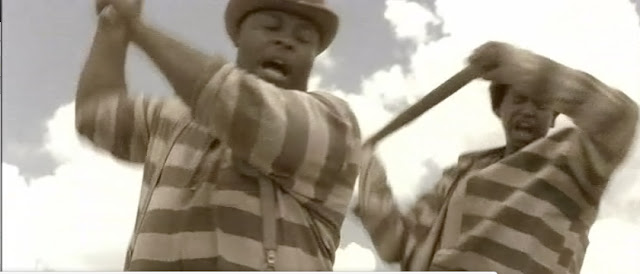O’Brother Where Art Thou?
Director: Joel Coen
Cinematographer: Roger Deakins
O’Brother where art thou? Starts off with an extreme wide
shot of an open field. The distant tree line and sky that takes up over
two-thirds of the frame represents the isolation and longing for freedom felt
by the characters. The completely desaturated color gives a since of age to the
film.
The shot very slowly pans to the chain gang breaking rocks
on the side of the road. The officers on the horses are close in the frame and
the gun is highly visible to show their imposing and unwavering dominance. The
shot is framed along the diagonal of the road and the line of the chain gang,
which leads to the vanishing point. This shot gives the illusion that the chain
gang goes on forever into the dusty distance. In this shot the color slowly
changes from completely desaturated to a sepia tone.
This shot a slow dolly shot framed low on the faceless
prisoners and looking upwards towards the guard. This shows the dominance of
the guard and the utter worthlessness felt by the prisoners.
This is another slow dolly shot that is framed upward
towards the prisoners. This is the first shot to clearly show any faces. This
could indicate there true humanity is much more important that that of the law
officers. This is to make the connection with the audience with the traditional
“bad guys.” This shot is framed high to show the sky in half of the frame, this
is to show the prisoners longing for freedom. This shot ends on a very young
looking prisoner show the indifference of the law toward juvenile offenders in
this age.
This shot starts with a close up of the back of one of the
prisoners, then pans to the diagonal of the chain gang. This shot show the
rhythm of the chain gang together and the unity the prisoners have with one
another.
This shot is a downward facing dolly shot going down the
line in-between the prisoners. The chains are framed on both lines of the left
and right thirds. This shot clearly represents the depression felt by the
prisoners by showing the physical chains that bind them. This also shows how
the prisoners are bound to one another.
This shot is
farmed low on the near talent and has a wide depth of field. In the left of the
frame is the almost smiling face of a prisoner, and in the right of the frame
is the stern face of a guard. This shot shows the conflicting attitudes of the
two sides of opposing characters that is reveled throughout movie.
This is an extremely low shot of the prisoners’ feet and the
rocks they are breaking. This shot has a very shallow depth of field, and in
the distance is a guard. This shot has a lot of dust and debris in the air each
time the rocks are hit. This shot seems to solidify the rigid structure these
men are living under and their hopelessness.
This is a two shot of prisoners. This shot give a good since
of the humanity of the prisoners.
This shot is almost a reverse shot of the opening shot. Although
in this shot the camera is more of a tracking dolly shot in which the guard on
horseback rides through, the guard’s gun is highly visible in the shot once
again. The vanishing point illusion is once again used. This shot reiterates
the dominance and seriousness of the guards.










No comments:
Post a Comment